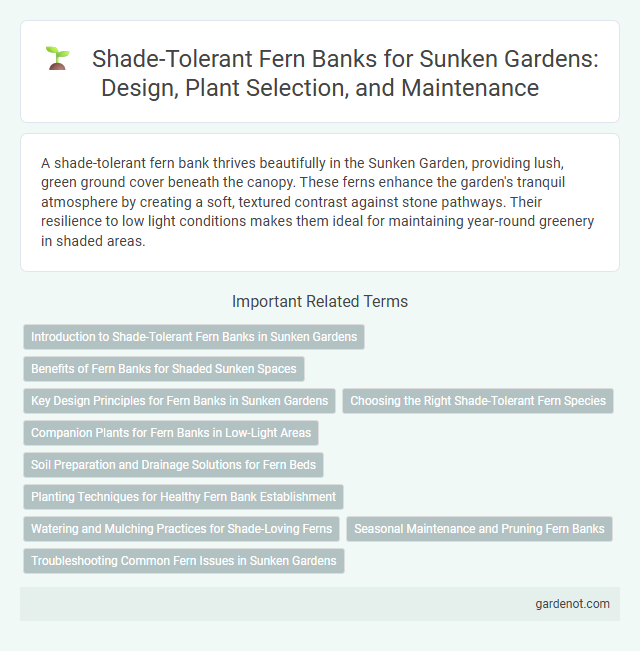A shade-tolerant fern bank thrives beautifully in the Sunken Garden, providing lush, green ground cover beneath the canopy. These ferns enhance the garden's tranquil atmosphere by creating a soft, textured contrast against stone pathways. Their resilience to low light conditions makes them ideal for maintaining year-round greenery in shaded areas.
Introduction to Shade-Tolerant Fern Banks in Sunken Gardens
Shade-tolerant fern banks in sunken gardens create lush, verdant underlayers that thrive in low-light conditions beneath tree canopies or structural shade. These banks often feature a diverse range of ferns such as maidenhair, Christmas, and ostrich ferns, which enhance biodiversity and provide year-round greenery. Their ability to retain moisture and prevent soil erosion also makes them essential for maintaining the ecological balance within sunken garden landscapes.
Benefits of Fern Banks for Shaded Sunken Spaces
Fern banks thrive in shaded sunken gardens by enhancing soil stability and reducing erosion with their dense root systems. These shade-tolerant plants improve air quality by filtering pollutants and increasing oxygen levels in low-light environments. Their lush foliage provides year-round greenery, enriching aesthetic appeal while supporting local biodiversity through habitat creation.
Key Design Principles for Fern Banks in Sunken Gardens
Shade-tolerant fern banks in sunken gardens require strategic layering to maximize moisture retention and enhance microclimate conditions for optimal fern growth. Selecting native fern species with high shade adaptability ensures longevity and ecosystem compatibility, while incorporating organic mulch and well-drained soil promotes root health and resilience. Design principles emphasize naturalistic groupings and gradual height transitions to create visual depth and maintain the serene ambiance of sunken garden spaces.
Choosing the Right Shade-Tolerant Fern Species
Selecting the appropriate shade-tolerant fern species for a sunken garden involves considering factors such as soil moisture, light conditions, and available space. Popular choices include the Autumn Fern (Dryopteris erythrosora), Japanese Painted Fern (Athyrium niponicum), and Lady Fern (Athyrium filix-femina) due to their adaptability and decorative foliage. These species thrive in low-light environments, provide diverse textures, and enhance the garden's understory with vibrant green hues.
Companion Plants for Fern Banks in Low-Light Areas
Shade-tolerant fern banks thrive in low-light environments by pairing with companion plants such as hostas, astilbes, and heucheras, which complement the ferns' delicate fronds with contrasting textures and colors. Ferns like the Japanese painted fern and the maidenhair fern benefit from the moisture-retentive soil supported by these companion plants. This combination not only enhances aesthetic appeal in sunken garden areas but also promotes a healthy microenvironment with balanced humidity and shade.
Soil Preparation and Drainage Solutions for Fern Beds
For shade-tolerant fern banks in sunken gardens, soil preparation must prioritize rich, well-draining, and acidic soil with a pH between 5.5 and 6.5 to support optimal fern growth. Incorporating organic matter such as peat moss, compost, and leaf mold improves soil texture and moisture retention while maintaining adequate drainage to prevent root rot. Installing subsurface drainage systems or raised beds ensures excess water is efficiently channeled away, creating a stable environment for ferns to thrive in shaded, moist conditions.
Planting Techniques for Healthy Fern Bank Establishment
Establishing a healthy shade-tolerant fern bank requires selecting fern species adapted to low-light conditions, such as Athyrium niponicum and Dryopteris erythrosora. Proper soil preparation with rich organic matter and consistent moisture retention is crucial to promote root growth and prevent fungal diseases. Strategic spacing and mulching enhance air circulation and moisture conservation, ensuring robust fern development in sunken garden environments.
Watering and Mulching Practices for Shade-Loving Ferns
Watering shade-tolerant fern banks in sunken gardens requires consistently moist, well-drained soil to prevent dehydration while avoiding waterlogged conditions that cause root rot. Applying a 2-3 inch layer of organic mulch, such as shredded leaves or bark, helps retain soil moisture, regulate temperature, and suppress weed growth around shade-loving ferns. Regular monitoring for soil moisture and replenishing mulch seasonally ensures optimal hydration and healthy fern growth in shaded environments.
Seasonal Maintenance and Pruning Fern Banks
Seasonal maintenance of shade-tolerant fern banks in a sunken garden involves removing dead or yellowing fronds during early spring to promote healthy growth. Pruning should be done carefully to avoid damaging new shoots, typically by trimming back old, woody fronds in late winter or early spring before new growth emerges. Regular maintenance enhances the aesthetic appeal and prevents fungal diseases by improving air circulation within the dense fern canopy.
Troubleshooting Common Fern Issues in Sunken Gardens
Shade-tolerant fern banks in sunken gardens often face challenges such as yellowing fronds, which typically indicate overwatering or poor drainage. Inspect soil moisture regularly to prevent root rot and ensure adequate airflow to reduce fungal infections common in shaded, humid environments. Applying a balanced, slow-release fertilizer can help address nutrient deficiencies and promote healthy fern growth.
Shade-tolerant fern bank Infographic

 gardenot.com
gardenot.com